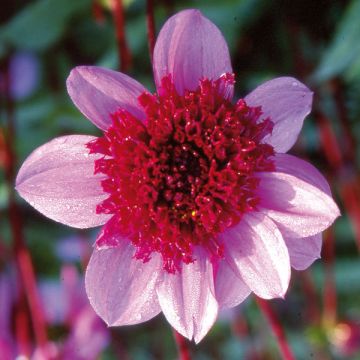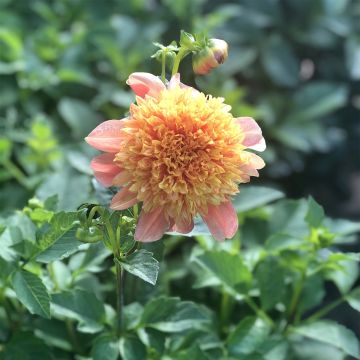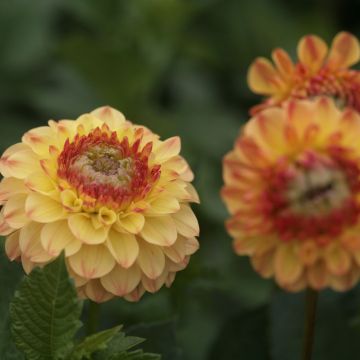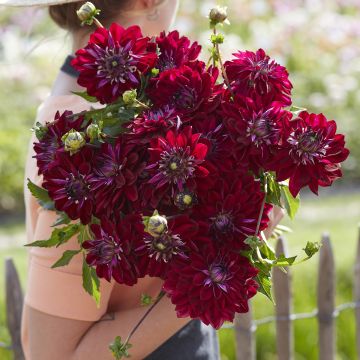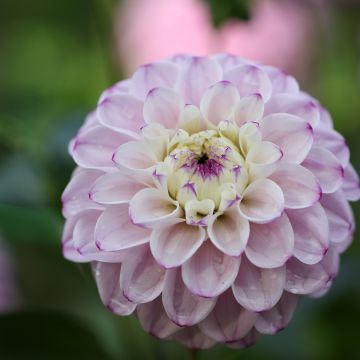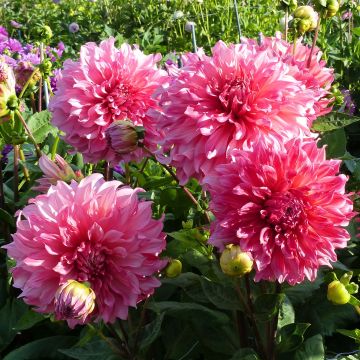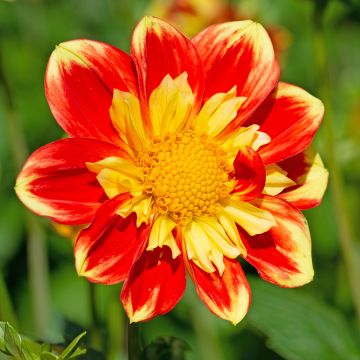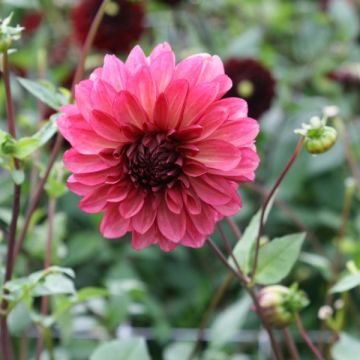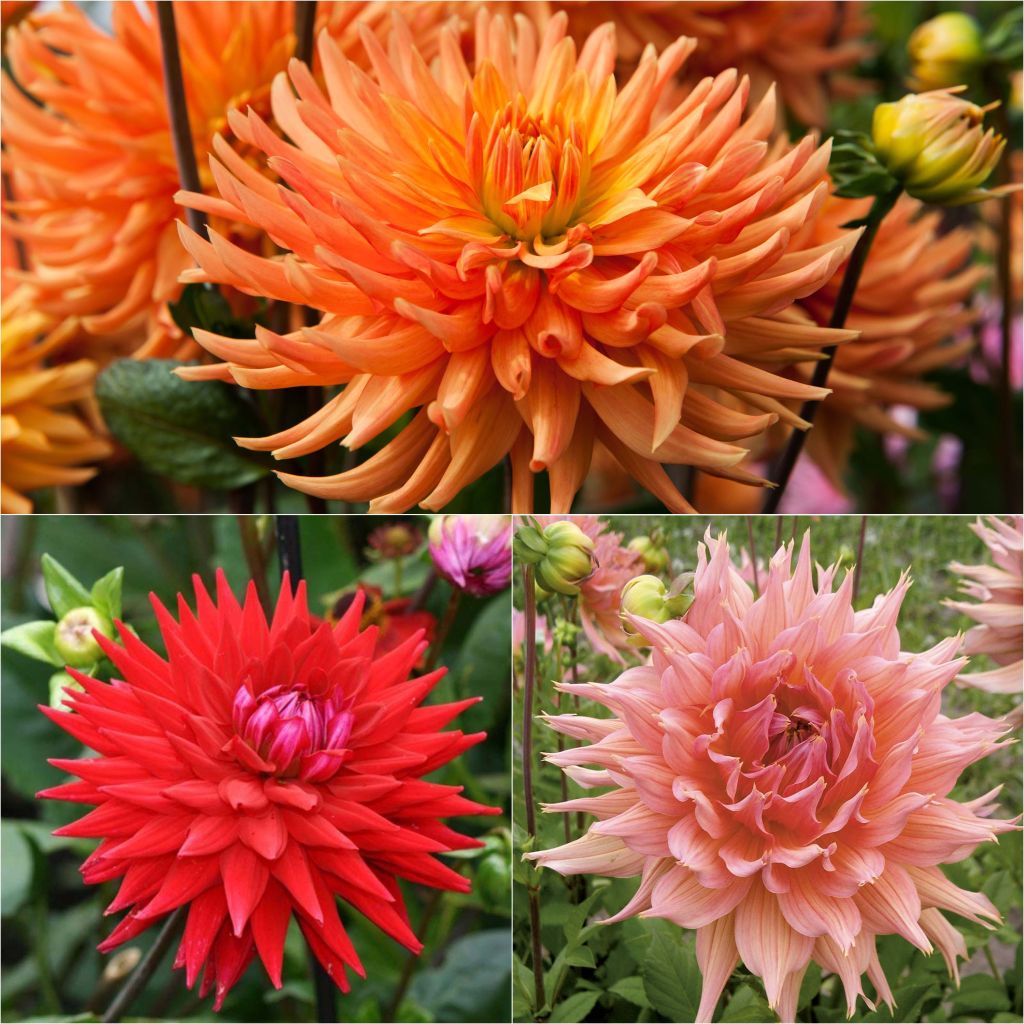

Collection of 3 semi-cactus dahlias, warm tones
Collection of 3 semi-cactus dahlias, warm tones
Dahlia Groupe semi-cactus Omega, Ludwig Helfert et Witteman's Best
This item cannot be shipped to the selected country
Delivery charge from €5.90
More information
Schedule delivery date,
and select date in basket
This plant carries a 6 months recovery warranty
More information
We guarantee the quality of our plants for a full growing cycle, and will replace at our expense any plant that fails to recover under normal climatic and planting conditions.
From €5.90 for pickup delivery and €6.90 for home delivery
Express home delivery from €8.90.
Does this plant fit my garden?
Set up your Plantfit profile →
Collection items (3 plants)
Description
A collection of 3 semi-cactus Dahlias in warm tones. Their large flowers, all bristling with tubular and dentate petals, showcase a joyful palette of orange, yellow, salmon pink, and bright red hues. They bloom abundantly from July until the first frost, creating remarkably colorful spots among tall perennials and bushes. You can also create beautiful homemade bouquets with asters and grass flowers.
This collection consists of:
-1x Dahlia semi-cactus 'Omega': large flowers of approximately 20 cm (8in), globular, with a salmon pink color tinged with yellow, carried at the end of purplish floral stems. Height: 1 m (3ft)
-1x Dahlia cactus 'Ludwig Helfert': 15 cm (6in) flowers, rounded, fully double, with completely rolled ligulate petals, in a beautiful light orange color, very bright. This variety is particularly floriferous. Height: 1.10 m
-1x Dahlia semi-cactus 'Witteman's Best' (synonym Superba): on 1.30 m (4ft) stems, 15 to 20 cm (6 to 8in) wide flowers filled with pointed petals, in a crimson red color, darkened at the heart with shades of violet.
To encourage repeat flowering, make sure to cut off faded flowers, or even better, regularly make large colorful bouquets by combining them with other varieties. With their variegated and flamboyant flowers, the dahlias in this collection go particularly well with orange, red, yellow, or white flowers. In flower beds, combine them with Asters for example, which bloom at the same time, as well as grass flowers at their peak of beauty. Also consider Heleniums and Echinaceas. They also allow you to enhance bouquets until late in the season.
A star plant for borders and herb gardens, Dahlias confidently accompany the most beautiful flowers but are also appreciated alongside vegetable plants. In Mexico, this tuberous plant was initially cultivated as a root vegetable for consumption. However, its poor taste assigned it the status of an ornamental plant. Since then, the interest in their beautiful exuberance has never waned.
Report an error about the product description
Plant habit
Flowering
Foliage
Botanical data
Dahlia
Groupe semi-cactus
Omega, Ludwig Helfert et Witteman's Best
Asteraceae
Cultivar or hybrid
Other Dahlias
Planting and care
Plant your dahlias in the spring in a deeply worked and enriched soil, for example with crushed bone or dehydrated blood. Place your tuber and crumble the soil well to fill without any air pockets. Your dahlia should be covered with 6 cm (2in) of soil. At the end of planting, pour a litre of water. Water regularly during the first 6 weeks to aid in rooting. Dahlias are sensitive to cold, so they need to be overwintered. In November, the first frosts will blacken the foliage, indicating it's time to dig them up. Carefully unearth the tubers, removing as much soil as possible. Let the foliage dry so that the tuber can replenish its reserves. Once the foliage is dry, cut the stems to 10 cm (4in) from the tuber. Spread your bulbs on a newspaper in a box. Store in a frost-free, dry, cool, and dark place.
Planting period
Intended location
Care
This item has not been reviewed yet - be the first to leave a review about it.
Haven't found what you were looking for?
Hardiness is the lowest winter temperature a plant can endure without suffering serious damage or even dying. However, hardiness is affected by location (a sheltered area, such as a patio), protection (winter cover) and soil type (hardiness is improved by well-drained soil).

Photo Sharing Terms & Conditions
In order to encourage gardeners to interact and share their experiences, Promesse de fleurs offers various media enabling content to be uploaded onto its Site - in particular via the ‘Photo sharing’ module.
The User agrees to refrain from:
- Posting any content that is illegal, prejudicial, insulting, racist, inciteful to hatred, revisionist, contrary to public decency, that infringes on privacy or on the privacy rights of third parties, in particular the publicity rights of persons and goods, intellectual property rights, or the right to privacy.
- Submitting content on behalf of a third party;
- Impersonate the identity of a third party and/or publish any personal information about a third party;
In general, the User undertakes to refrain from any unethical behaviour.
All Content (in particular text, comments, files, images, photos, videos, creative works, etc.), which may be subject to property or intellectual property rights, image or other private rights, shall remain the property of the User, subject to the limited rights granted by the terms of the licence granted by Promesse de fleurs as stated below. Users are at liberty to publish or not to publish such Content on the Site, notably via the ‘Photo Sharing’ facility, and accept that this Content shall be made public and freely accessible, notably on the Internet.
Users further acknowledge, undertake to have ,and guarantee that they hold all necessary rights and permissions to publish such material on the Site, in particular with regard to the legislation in force pertaining to any privacy, property, intellectual property, image, or contractual rights, or rights of any other nature. By publishing such Content on the Site, Users acknowledge accepting full liability as publishers of the Content within the meaning of the law, and grant Promesse de fleurs, free of charge, an inclusive, worldwide licence for the said Content for the entire duration of its publication, including all reproduction, representation, up/downloading, displaying, performing, transmission, and storage rights.
Users also grant permission for their name to be linked to the Content and accept that this link may not always be made available.
By engaging in posting material, Users consent to their Content becoming automatically accessible on the Internet, in particular on other sites and/or blogs and/or web pages of the Promesse de fleurs site, including in particular social pages and the Promesse de fleurs catalogue.
Users may secure the removal of entrusted content free of charge by issuing a simple request via our contact form.
The flowering period indicated on our website applies to countries and regions located in USDA zone 8 (France, the United Kingdom, Ireland, the Netherlands, etc.)
It will vary according to where you live:
- In zones 9 to 10 (Italy, Spain, Greece, etc.), flowering will occur about 2 to 4 weeks earlier.
- In zones 6 to 7 (Germany, Poland, Slovenia, and lower mountainous regions), flowering will be delayed by 2 to 3 weeks.
- In zone 5 (Central Europe, Scandinavia), blooming will be delayed by 3 to 5 weeks.
In temperate climates, pruning of spring-flowering shrubs (forsythia, spireas, etc.) should be done just after flowering.
Pruning of summer-flowering shrubs (Indian Lilac, Perovskia, etc.) can be done in winter or spring.
In cold regions as well as with frost-sensitive plants, avoid pruning too early when severe frosts may still occur.
The planting period indicated on our website applies to countries and regions located in USDA zone 8 (France, United Kingdom, Ireland, Netherlands).
It will vary according to where you live:
- In Mediterranean zones (Marseille, Madrid, Milan, etc.), autumn and winter are the best planting periods.
- In continental zones (Strasbourg, Munich, Vienna, etc.), delay planting by 2 to 3 weeks in spring and bring it forward by 2 to 4 weeks in autumn.
- In mountainous regions (the Alps, Pyrenees, Carpathians, etc.), it is best to plant in late spring (May-June) or late summer (August-September).
The harvesting period indicated on our website applies to countries and regions in USDA zone 8 (France, England, Ireland, the Netherlands).
In colder areas (Scandinavia, Poland, Austria...) fruit and vegetable harvests are likely to be delayed by 3-4 weeks.
In warmer areas (Italy, Spain, Greece, etc.), harvesting will probably take place earlier, depending on weather conditions.
The sowing periods indicated on our website apply to countries and regions within USDA Zone 8 (France, UK, Ireland, Netherlands).
In colder areas (Scandinavia, Poland, Austria...), delay any outdoor sowing by 3-4 weeks, or sow under glass.
In warmer climes (Italy, Spain, Greece, etc.), bring outdoor sowing forward by a few weeks.




































